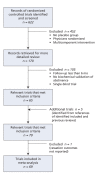Pharmacotherapies for smoking cessation: a meta-analysis of randomized controlled trials
- PMID: 18625984
- PMCID: PMC2443223
- DOI: 10.1503/cmaj.070256
Pharmacotherapies for smoking cessation: a meta-analysis of randomized controlled trials
Erratum in
- CMAJ. 2008 Oct 7;179(8):802
Abstract
Background: Many placebo-controlled trials have demonstrated the efficacy of individual pharmacotherapies approved for smoking cessation. However, few direct or indirect comparisons of such interventions have been conducted. We performed a meta-analysis to compare the treatment effects of 7 approved pharmacologic interventions for smoking cessation.
Methods: We searched the US Centers for Disease Control and Prevention's Tobacco Information and Prevention database as well as MEDLINE, EMBASE and the Cochrane Library for published reports of placebo-controlled, double-blind randomized controlled trials of pharmacotherapies for smoking cessation. We included studies that reported biochemically validated measures of abstinence at 6 and 12 months. We used a hierarchical Bayesian random-effects model to summarize the results for each intervention.
Results: We identified 70 published reports of 69 trials involving a total of 32 908 patients. Six of the 7 pharmacotherapies studied were found to be more efficacious than placebo: varenicline (odds ratio [OR] 2.41, 95% credible interval [CrI] 1.91-3.12), nicotine nasal spray (OR 2.37, 95% CrI 1.12-5.13), bupropion (OR 2.07, 95% CrI 1.73-2.55), transdermal nicotine (OR 2.07, 95% CrI 1.69-2.62), nicotine tablet (OR 2.06, 95% CrI 1.12-5.13) and nicotine gum (OR 1.71, 95% CrI 1.35-2.21). Similar results were obtained regardless of which measure of abstinence was used. Although the point estimate favoured nicotine inhaler over placebo (OR 2.17), these results were not conclusive because the credible interval included unity (95% CrI 0.95-5.43). When all 7 interventions were included in the same model, all were more efficacious than placebo. In our analysis of data from the varenicline trials that included bupropion control arms, we found that varenicline was superior to bupropion (OR 2.18, 95% CrI 1.09-4.08).
Interpretation: Varenicline, bupropion and the 5 nicotine replacement therapies were all more efficacious than placebo at promoting smoking abstinence at 6 and 12 months.
Figures







Comment in
-
The missing link in tobacco control.CMAJ. 2008 Jul 15;179(2):123-4. doi: 10.1503/cmaj.080855. CMAJ. 2008. PMID: 18625975 Free PMC article. No abstract available.
-
Smoking cessation trials.CMAJ. 2008 Nov 4;179(10):1037-8; author reply 138. doi: 10.1503/cmaj.1080096. CMAJ. 2008. PMID: 18981448 Free PMC article. No abstract available.
-
Review: varenicline, bupropion, and nicotine replacement therapies are effective for smoking cessation at 6 or 12 months.Evid Based Nurs. 2009 Jan;12(1):10. doi: 10.1136/ebn.12.1.10. Evid Based Nurs. 2009. PMID: 19103828 No abstract available.
Comment on
-
Intentions of smokers to use free nicotine replacement therapy.CMAJ. 2008 Jul 15;179(2):145-6. doi: 10.1503/cmaj.071241. CMAJ. 2008. PMID: 18625985 Free PMC article.
References
-
- Foulds J. The neurobiological basis for partial agonist treatment of nicotine dependence: varenicline. Int J Clin Pract 2006;60:571-6. - PubMed
-
- Gonzales D, Rennard SI, Nides M, et al. Varenicline, an alpha4beta2 nicotinic acetylcholine receptor partial agonist, vs sustained-release bupropion and placebo for smoking cessation: a randomized controlled trial. JAMA 2006;296:47-55. - PubMed
-
- Jorenby DE, Hays JT, Rigotti NA, et al. Efficacy of varenicline, an alpha4beta2 nicotinic acetylcholine receptor partial agonist, vs placebo or sustained-release bupropion for smoking cessation: a randomized controlled trial. JAMA 2006;296: 56-63. - PubMed
-
- Nides M, Oncken C, Gonzales D, et al. Smoking cessation with varenicline, a selective alpha4beta2 nicotinic receptor partial agonist: results from a 7-week, randomized, placebo-and bupropion-controlled trial with 1-year follow-up. Arch Intern Med 2006;166:1561-8. - PubMed
-
- Oncken C, Gonzales D, Nides M, et al. Efficacy and safety of the novel selective nicotinic acetylcholine receptor partial agonist, varenicline, for smoking cessation. Arch Intern Med 2006;166:1571-7. - PubMed
Publication types
MeSH terms
Substances
LinkOut - more resources
Full Text Sources
Medical
